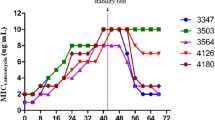Abstract
In last decade methicillin-resistant Staphylococcus aureus with high level of vancomycin-resistance (VRSA) have been reported and generally the patients with VRSA infection were also infected with a vancomycin-resistant Enterococcus (VRE). Considering that the high level of vancomycin-resistance in VRSA isolates seems to involve the horizontal transfer of Tn1546 transposon containing vanA gene from coinfecting VRE strains, the authors have studied the “in vitro” conjugative transfer of this resistance from VanA enterococci to S. aureus. Out of 25 matings performed combining five vancomycin-resistant enterococci as donors (three Enterococcus faecalis and two Enterococcus faecium), and five S. aureus as recipients, all clinical isolates, two have been successful using E. faecalis as donor. The transfer of vancomycin-resistance was confirmed by vanA gene amplification in both transconjugants and the resistance was expressed at lower levels (MIC 32 μg/ml) in comparison with the respective VRE donors (MIC > 128 μg/ml). The vancomycin-resistance of trasconjugants was maintained even after subsequent overnight passages on MSA plates containing subinhibitory levels of vancomycin. This study shows that the vanA gene transfer can be achieved through techniques “in vitro” without the use of laboratory animals employed, in the only similar experiment previously carried out by other authors, as substrate for the trasconjugant growth. Moreover, in that previous experiment, contrary to this study, the vancomycin resistant S. aureus trasconjugants were selected on erythromycin agar and not by direct vancomycin agar selection.


Similar content being viewed by others
References
CDC (2010) Reminds clinical laboratories and healthcare infection preventionists of their role in the search and containment of vancomycin-resistant Staphylococcus aureus (VRSA), May 2010
Chang S, Sievert DM, Hageman JC, Boulton ML, Tenover FC, Downes F, Shah S, Rudrik JT, Pupp GR, Brown WJ, Cardo D, Fridkin SK (2003) Infection with vancomycin-resistant Staphylococcus aureus containing the vanA resistance gene. N Engl J Med 348:1342–1347
Clinical and Laboratory Standards Institute (CLSI) (2008) Performance standards for antimicrobial susceptibility testing; 18th informational supplement M100–S18. CLSI, Wayne
de Niederhäusern S, Sabia C, Messi P, Guerrieri E, Manicardi G, Bondi M (2004) Glycopeptide-resistance transferability from vancomycin-resistant enterococci of human and animal source to Listeria spp. Lett Appl Microbiol 39:483–489
Dutka-Malen S, Evers S, Courvalin P (1995) Detection of glycopeptide resistance genotypes and identification to the species level of clinically relevant enterococci by PCR. J Clin Microbiol 33:24–27
Liu C, Chambers HF (2003) Staphylococcus aureus with heterogeneous resistance to vancomycin: epidemiology, clinical significance, and critical assessment of diagnostic methods. Antimicrob Agents Chemother 47:3040–3045
Macrina FL, Kopecko DJ, Jones KR, Ayers DJ, Mc Cowen SM (1978) A multiple plasmid-containing Escherichia coli strain: convenient source of size reference plasmid molecules. Plasmid 1:417–1420
McGowan JE, Tenover FC (2004) Opinion-anti-infectives: confronting bacterial resistance in healthcare settings: a crucial role for microbiologists. Nat Rev Microbiol 2:251–258
National Committee for Clinical Laboratory Standards (NCCLS) (2003) Methods for dilution antimicrobial susceptibility tests for bacteria that grow aerobically. Approved standard, M7–A6, 6th edn. NCCLS, Wayne
Noble WC, Virani Z, Cree RG (1992) Co-transfer of vancomycin and other resistance genes from Enterococcus faecalis NCTC 12201 to Staphylococcus aureus. FEMS Microbiol Lett 72:195–198
O’Sullivan DJ, Klaenhammer R (1993) Rapid Mini-Prep isolation of high-quality plasmid DNA from Lactococcus and Lactobacillus spp. Appl Environ Microbiol 59:2730–2733
Périchon B, Courvalin P (2009) VanA-type vancomycin-resistant Staphylococcus aureus. Antimicrob Agents Chemother 53:4580–4587
Raney PM, Williams PP, McGowan JE, Tenover FC (2002) Validation of Vitek version 7. 01 software for testing staphylococci against vancomycin. Diagn Microbiol Infect Dis 43:135–140
Sabia C, de Niederhäusern S, Guerrieri E, Messi P, Anacarso I, Manicardi G, Bondi M (2007) Detection of bacteriocin production and virulence traits in vancomycin-resistant enterococci of different sources. J Appl Microbiol 104:970–979
Saha B, Singh AK, Ghosh A, Ball M (2008) Identification and characterization of a vancomycin-resistant Staphylococcus aureus isolated from Kolkata (South Asia). J Med Microbiol 57:72–79
Severin A, Tabei K, Tenover F, Chung M, Clarke N, Tomasz A (2004) High level oxacillin and vancomycin resistance and altered cell wall composition in Staphylococcus aureus carrying the staphylococcal mecA and the enterococcal vanA gene complex. J Biol Chem 279:3398–3407
Tenover FC, Weigel LM, Appelbaum PC et al (2004) Vancomycin-resistant Staphylococcus aureus isolate from a patient in Pennsylvania. Antimicrob Agents Chemother 48:275–280
Weigel LM, Clewell Don B, Gill SR, Clark NC, McDougal LK, Flannagan SE, Kolonay JF, Shetty J, Killgore GE, Tenover FC (2003) Genetic analysis of a high-level vancomycin-resistant isolate of Staphylococcus aureus. Science 302:1569–1571
Zhu W, Clark NC, McDougal LK, Hageman J, McDonald LC, Patel JB (2008) Vancomycin-resistant Staphylococcus aureus isolates associated with Inc18-Like vanA plasmids in Michigan. Antimicrob Agents Chemother 52:452–457
Zhu W, Murray PR, Huskins WC et al (2010) Dissemination of an Enterococcus Inc18-Like vanA plasmid associated with vancomycin-resistant Staphylococcus aureus. Antimicrob Agents Chemother 54:4214–4320
Author information
Authors and Affiliations
Corresponding author
Rights and permissions
About this article
Cite this article
de Niederhäusern, S., Bondi, M., Messi, P. et al. Vancomycin-resistance Transferability from VanA Enterococci to Staphylococcus aureus . Curr Microbiol 62, 1363–1367 (2011). https://doi.org/10.1007/s00284-011-9868-6
Received:
Accepted:
Published:
Issue Date:
DOI: https://doi.org/10.1007/s00284-011-9868-6




